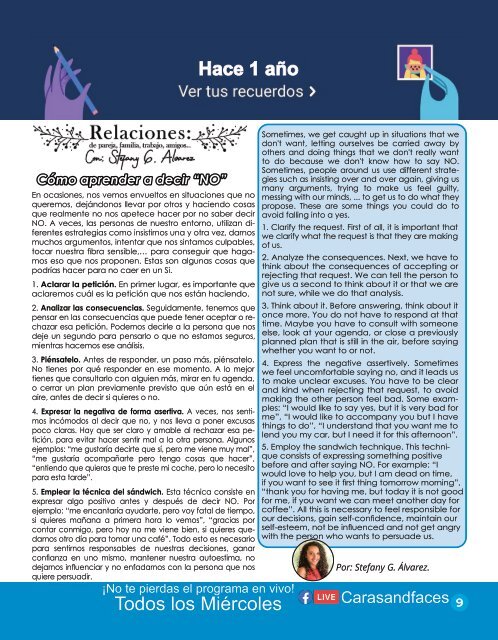Revista Octubre 2021
¡ESTE MES CELEBRA HALLOWEEN CON TU FAMILIA & AMIGOS!
¡ESTE MES CELEBRA HALLOWEEN CON TU FAMILIA & AMIGOS!
You also want an ePaper? Increase the reach of your titles
YUMPU automatically turns print PDFs into web optimized ePapers that Google loves.
Cómo aprender a decir “NO”<br />
En ocasiones, nos vemos envueltos en situaciones que no<br />
queremos, dejándonos llevar por otros y haciendo cosas<br />
que realmente no nos apetece hacer por no saber decir<br />
NO. A veces, las personas de nuestro entorno, utilizan diferentes<br />
estrategias como insistirnos una y otra vez, darnos<br />
muchos argumentos, intentar que nos sintamos culpables,<br />
tocar nuestra bra sensible,… para conseguir que hagamos<br />
eso que nos proponen. Estas son algunas cosas que<br />
podrías hacer para no caer en un Si.<br />
1. Aclarar la petición. En primer lugar, es importante que<br />
aclaremos cuál es la petición que nos están haciendo.<br />
2. Analizar las consecuencias. Seguidamente, tenemos que<br />
pensar en las consecuencias que puede tener aceptar o rechazar<br />
esa petición. Podemos decirle a la persona que nos<br />
deje un segundo para pensarlo o que no estamos seguros,<br />
mientras hacemos ese análisis.<br />
3. Piénsatelo. Antes de responder, un paso más, piénsatelo.<br />
No tienes por qué responder en ese momento. A lo mejor<br />
tienes que consultarlo con alguien más, mirar en tu agenda,<br />
o cerrar un plan previamente previsto que aún está en el<br />
aire, antes de decir si quieres o no.<br />
4. Expresar la negativa de forma asertiva. A veces, nos sentimos<br />
incómodos al decir que no, y nos lleva a poner excusas<br />
poco claras. Hay que ser claro y amable al rechazar esa petición,<br />
para evitar hacer sentir mal a la otra persona. Algunos<br />
ejemplos: “me gustaría decirte que sí, pero me viene muy mal”,<br />
“me gustaría acompañarte pero tengo cosas que hacer”,<br />
“entiendo que quieras que te preste mi coche, pero lo necesito<br />
para esta tarde”.<br />
5. Emplear la técnica del sándwich. Esta técnica consiste en<br />
expresar algo positivo antes y después de decir NO. Por<br />
ejemplo: “me encantaría ayudarte, pero voy fatal de tiempo,<br />
si quieres mañana a primera hora lo vemos”, “gracias por<br />
contar conmigo, pero hoy no me viene bien, si quieres quedamos<br />
otro día para tomar una café”. Todo esto es necesario<br />
para sentirnos responsables de nuestras decisiones, ganar<br />
conanza en uno mismo, mantener nuestra autoestima, no<br />
dejarnos inuenciar y no enfadarnos con la persona que nos<br />
quiere persuadir.<br />
Sometimes, we get caught up in situations that we<br />
don't want, letting ourselves be carried away by<br />
others and doing things that we don't really want<br />
to do because we don't know how to say NO.<br />
Sometimes, people around us use different strategies<br />
such as insisting over and over again, giving us<br />
many arguments, trying to make us feel guilty,<br />
messing with our minds, ... to get us to do what they<br />
propose. These are some things you could do to<br />
avoid falling into a yes.<br />
1. Clarify the request. First of all, it is important that<br />
we clarify what the request is that they are making<br />
of us.<br />
2. Analyze the consequences. Next, we have to<br />
think about the consequences of accepting or<br />
rejecting that request. We can tell the person to<br />
give us a second to think about it or that we are<br />
not sure, while we do that analysis.<br />
3. Think about it. Before answering, think about it<br />
once more. You do not have to respond at that<br />
time. Maybe you have to consult with someone<br />
else, look at your agenda, or close a previously<br />
planned plan that is still in the air, before saying<br />
whether you want to or not.<br />
4. Express the negative assertively. Sometimes<br />
we feel uncomfortable saying no, and it leads us<br />
to make unclear excuses. You have to be clear<br />
and kind when rejecting that request, to avoid<br />
making the other person feel bad. Some examples:<br />
“I would like to say yes, but it is very bad for<br />
me”, “I would like to accompany you but I have<br />
things to do”, “I understand that you want me to<br />
lend you my car, but I need it for this afternoon”.<br />
5. Employ the sandwich technique. This technique<br />
consists of expressing something positive<br />
before and after saying NO. For example: “I<br />
would love to help you, but I am dead on time,<br />
if you want to see it rst thing tomorrow morning”,<br />
“thank you for having me, but today it is not good<br />
for me, if you want we can meet another day for<br />
coffee”. All this is necessary to feel responsible for<br />
our decisions, gain self-condence, maintain our<br />
self-esteem, not be inuenced and not get angry<br />
with the person who wants to persuade us.<br />
Por: Stefany G. Álvarez.<br />
¡No te pierdas el programa en vivo!<br />
Todos los Miércoles<br />
Carasandfaces 9















